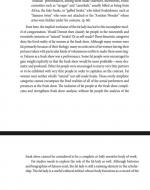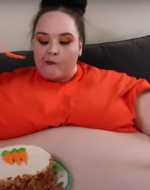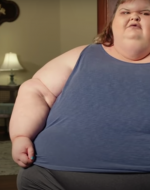Created by Ashley Dolt on Mon, 05/02/2022 - 04:40
Description:
During the perturbing and bizarre era of freakshows, there was a vast number of human beings who were paraded around and cast off by society as though they were peculiar circus creatures—accompanied by a vast number of human beings who peered at them on their stages, fascinated by their unusual physical appearances, and treated them as such. While these “freaks” were clearly isolated from the rest of society, many of them leaned into their uniqueness and embraced freakshows as a form of employment and perhaps as a way of obtaining the strongest sense of self-agency that society would be willing to grant them. That being said, there were two primary categories of “freaks” that one would see in a freakshow: those who were naturally born as “freaks” due to health or physical conditions out of their own control and freakshows were their only source of potential employment, and those who intentionally created or enhanced their “freakishness” in order to profit monetarily. One example of a particular facet of “freaks” that fell somewhere in the gray area between these two categories was morbidly overweight individuals, as one can debate whether or not they can control their “freakishness” or if this was an inborn disability. Interestingly, modern-day society continues to display, expose, fetishize, and curiously fixate on morbidly obese individuals on a grand scale similar to how this population of people was during the time of freakshows. Furthermore, there continue to be people within the morbidly obese community who lean into the societal stereotypes and fascination surrounding people of their size and purposely aim to monetize from this—even if it means they will be judged or made fun of. Likewise, society proceeds to debate whether or not obesity is totally in control of the individual or if it is linked to having a greater disability or medical problem.
Artifact #1:
Cantrell, Amber. “Freaking Fatness through History: Critical Intersections of Fatness and
Disability.” College of Charleston, College of Charleston, 2013,
chrestomathy.cofc.edu/documents/vol12/cantrell.pdf.
Dating all the way back to the time of Victorian freakshows, society collectively passed judgments on and debated about whether or not the condition of the morbidly obese individuals whom they looked to for entertainment were “natural-born” or “self-made.” In other words, there was a simultaneous prejudice and fascination toward the overweight community displayed in freakshows that was unlike any other collective, societal feeling and questioning toward other kinds of “freaks.” For example, some people in the audience of a freakshow might have viewed the morbidly obese “freaks” as inferior to the other freaks due to the fact that they, in a sense, created or facilitated their appearance on purpose. On the other hand, others might have pitied them and found comfort in knowing that they were supposedly better than the morbidly obese “freaks” due to their thinner appearance or because they likely did not experience the same level of limitation that those in the freakshow did. For instance, it was often that “freaks” could not find any sort of stable employment outside of the realm of freakshows. This debate about whether or not obese “freaks” are natural-born or self-made raises several questions. The primary question is: Was/is it wrong to purposely gain weight in order to “enhance one’s freakishness” so that they can be a part of the freakshow or circus when there are clearly natural-born freaks who use this as their only means of employment and self-agency? Modern-day society continues to debate this topic in regard to the variety of reality television shows surrounding morbid obesity, specifically on the popular network TLC.
Artifact #2:
Bates, Daniel. “The Real-Life American Horror Story: Freak Show.” Daily Mail
Online, Associated Newspapers, 23 Oct. 2015,www.dailymail.co.uk/news/article-
3283496/A-555-pound-woman-ate-10-000-calorie-DAY-diet-Zebraman-
bearded-lady-Meet-sideshow-freaks-1930s-went-laughed-overnight-sensations.html.
The era of morbidly obese people, as well as other “freaks” of nature, being put on grand displays did not conclude after the Victorian era—a time at which freakshows were at their prime in the entertainment industry—but rather never truly drew to a close. As a matter of fact, this mentality carried directly into American society in the 1900s during the time of the Great Depression when citizens were desperately struggling to make financial ends meet. That being said, if this meant one had to think outside of the box and pursue unorthodox methods in order to do so, then that is what one did to provide for themselves and their families. For instance, the respective image depicts poor American men and women who had deliberately “eaten themselves into the circus.” While these people were not necessarily naturally-born as “freaks” as others who had been forced into the freakshow had been, they willingly chose a lifestyle as self-made “freaks” in order to use their extreme obesity to their economic advantage during a time in history when the majority of society was genuinely struggling financially. This raises the question of whether or not this decision was morally correct due to multiple factors. One reason this could be morally incorrect is that if these individuals were able-bodied other than their intentional obesity, they could have possibly sought to make money in other ways that did not take away from the natural-born “freaks” who had no other options available to them. Another reason this could have been morally corrupt is that if they were not naturally-born as obese or with a strong tendency to gain significant weight, they were purposely exploiting and utilizing the disadvantages of those who cannot control their obesity for their own monetary gains. In contrast, one could argue that times were so tough during the Great Depression that they might have had no other choice.
Artifact #3:
“She's an 800-Lb Fetish Model | My 600-Lb Life.” YouTube, TLC, 2020,
www.youtube.com/watch?v=B5Nzrg-OlTI.
The age of society fascinating over extremely obese individuals has neither concluded nor does it appear that it is anywhere near a conclusion, as the popular television network TLC continues to thrive from their programs specifically based on obesity. One can observe in the respective video clip from TLC’s hit series My 600-lb Life as Samantha Mason, an 800-pound, morbidly obese woman, is exploited and fetishized solely on her especially large appearance as she posts a video of herself eating carrot cake. In fact, this particular clip highlights how much more accessible freakshows are available to a public audience, as one is a mere mouse click away from accessing any sort of content they desire. Moreover, this clip dives into the concept of natural-born versus self-made “freaks” from a different angle. For example, Samantha, having already been severely obese, was unable to enter any other line of work other than “fetish modeling” due to her size. While one can argue that she reached the initial point of morbid obesity based on her own life decisions prior to becoming home-bound, one can also argue that Samantha’s subsequent career of “fetish modeling” in which she posted videos of herself eating large portions of food was her only option to making any sort of substantial income. Moreover, this forced career path deepened her spiral into obesity, thus cultivating a vicious cycle she was unable to break and becoming even further detrimental to her health. Therefore, from this perspective, one could perhaps consider Samantha a hybrid between natural-born and self-made “freak.”
Artifact #4:
“Tammy Is Getting More Hate Online | 1000-Lb Sisters.” YouTube, TLC, 2020,
www.youtube.com/watch?v=73x93bbYcy4&list=PLb6EEuKE-oAaSx
VU36MIwhb_meC_61p96&index=65.
The contemporary freakshow in American culture centered around the exploitation, fetishization, and unbridled fascination with obesity does not stop at My 600-lb Life. In fact, TLC recently introduced a newer television series entitled the 1000-lb Sisters that follows the weight journey of two sisters who weigh approximately one thousand pounds combined, Amy and Tammy Slaton, from Dixon, Kentucky. Throughout the series, the viewer also catches glimpses of the sisters’ daily lives, which includes the filming and production of their YouTube channel that they use to make an income. In the provided video clip from the television series, Amy and Tammy are discussing recent comments that the public has been leaving underneath their YouTube videos. Amy—the sister who underwent gastric bypass surgery and lost a significant amount of weight by this point—had been receiving an overwhelmingly increased number of kind comments from the viewers telling her how much healthier and better she looked now that she has lost a lot of weight. On the other hand, Tammy mentioned how she had been receiving an overwhelmingly increased number of hateful, mean-spirited comments directed toward her weight. Fascinatingly, this goes to show society’s deeply-rooted prejudice toward extreme obesity and raises the question of whether or not this cultural bias is ableist or not. For instance, a vast number of those experiencing morbid obesity—such as Tammy Slaton—have an uncontrolled food addiction and/or related health conditions that precipitated from their tremendous weight gain. When considering morbid obesity through this lens, it is clear that one can view obesity as a form of disability. Therefore, when society hates on and negatively judges extremely obese individuals based on their physical appearance, they are demonstrating a specific, pointed form of ableism. Additionally, despite the fact that Tammy was hurt by the hateful comments the public was leaving underneath her and her sister’s YouTube videos, the two still continued to create and post videos on their channel for money. This goes to show that “freaks” continue to lean into their unusual conditions in modern society in order to make a living, as they do not have any other options available to them for stable employment or income.





